To the casual observer, many mites are just mysterious little red dots. Gardeners and farmers will be familiar with the spider mite family, Tetranychidae. These mites are plant-eaters, and many are major agricultural pests worldwide.
But there are so many other kinds of mites—more than you know. More than I know! More than even acarologists (mite scientists) know. They have described about 50,000 species, but they think there are probably at least a million in total.1 If you take a closer look at the little red dots running around, you can find many different kinds, occupying many different ecological niches, all unique and delightful to watch. (Red is a popular mite colour; it probably tells bigger animals that they taste bad.)
However, it is surprisingly hard to find good information about them. Pest control companies, news outlets, and even Wikipedia frequently misidentify photos of mites. So I made the infographic above to help you tell apart some of the most common small red mites you’ll encounter (that aren’t the classic spider mites). Images of text are not very accessible, so I’ve also included the write-ups below. I wanted to use illustrations rather than photos, to exaggerate important characteristics and express the mites’ “personalities”. But I’ve also included links to the BugGuide taxa pages if you want to look at comparison photos.
I’m not a mite expert by any means. So if there are any mistakes in the text or illustrations, please let me know, and I will fix them as best as I can!
Red Velvet Mite
Family Trombidiidae, common genera: Trombidium, Allothrombium [BugGuide]
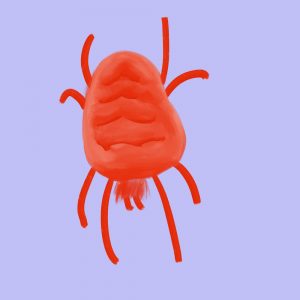
- soft plush velvety warm red coat
- blobby, slightly flattened body
- wrinkly and bumbling and squishy like a
Shar-Pei puppy - parasites of other arthropods as larvae, predators/scavengers as adults
- harmless and beneficial
- NOT a clover mite
- NOT a spider mite
Sidewalk Mite
Family Erythraeidae, genus Balaustium [BugGuide]
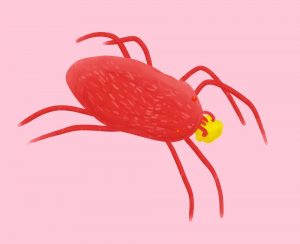
- very short velvety coat the colour of raspberry jam
- pill-shaped body with long skinny legs
- like to run around fast on concrete
- many are parasites of other arthropods as larvae and predators as adults, some only eat pollen
- harmless and beneficial
- NOT a clover mite
- NOT a spider mite
Whirligig Mite
Family Anystidae, genus Anystis [BugGuide]
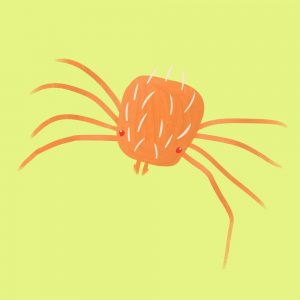
- orangey-red to cherry-red body, smooth with
long, sparse, coarse pale hairs - squat isosceles trapezoidal body with star-like leg arrangement, wide-set beady little eyes
- like to run around REALLY FUCKING FAST on leaves, sometimes do lunges to stretch first
- predators that eat garden pests and even each other
- harmless and beneficial
- NOT a clover mite
- NOT a spider mite
Clover Mite
Family Tetranychidae, genus Bryobia [BugGuide]
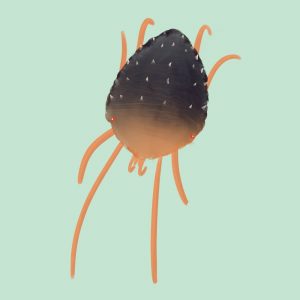
- bluish to reddish body with long skinny salmon-pink legs
- wrinkled body with scattering of scale-like white hairs
- absolutely fucking tiny
- like if you can get a decent photo of it with your phone, it’s not a clover mite
- eat grass and leaves and stuff
- can cause cosmetic damage to lawns, but lawns are bad for the environment anyway, therefore they’re beneficial
- a clover mite
- yes, this is really what clover mites look like, everyone is wrong
- a spider mite (but doesn’t make silk like Tetranychus and other cousins)
- Walter, D.E. & Proctor, H.C. (2013). Mites: Ecology, evolution & behaviour: Life at a microscale (2nd ed.) [Sci-Hub] ↩
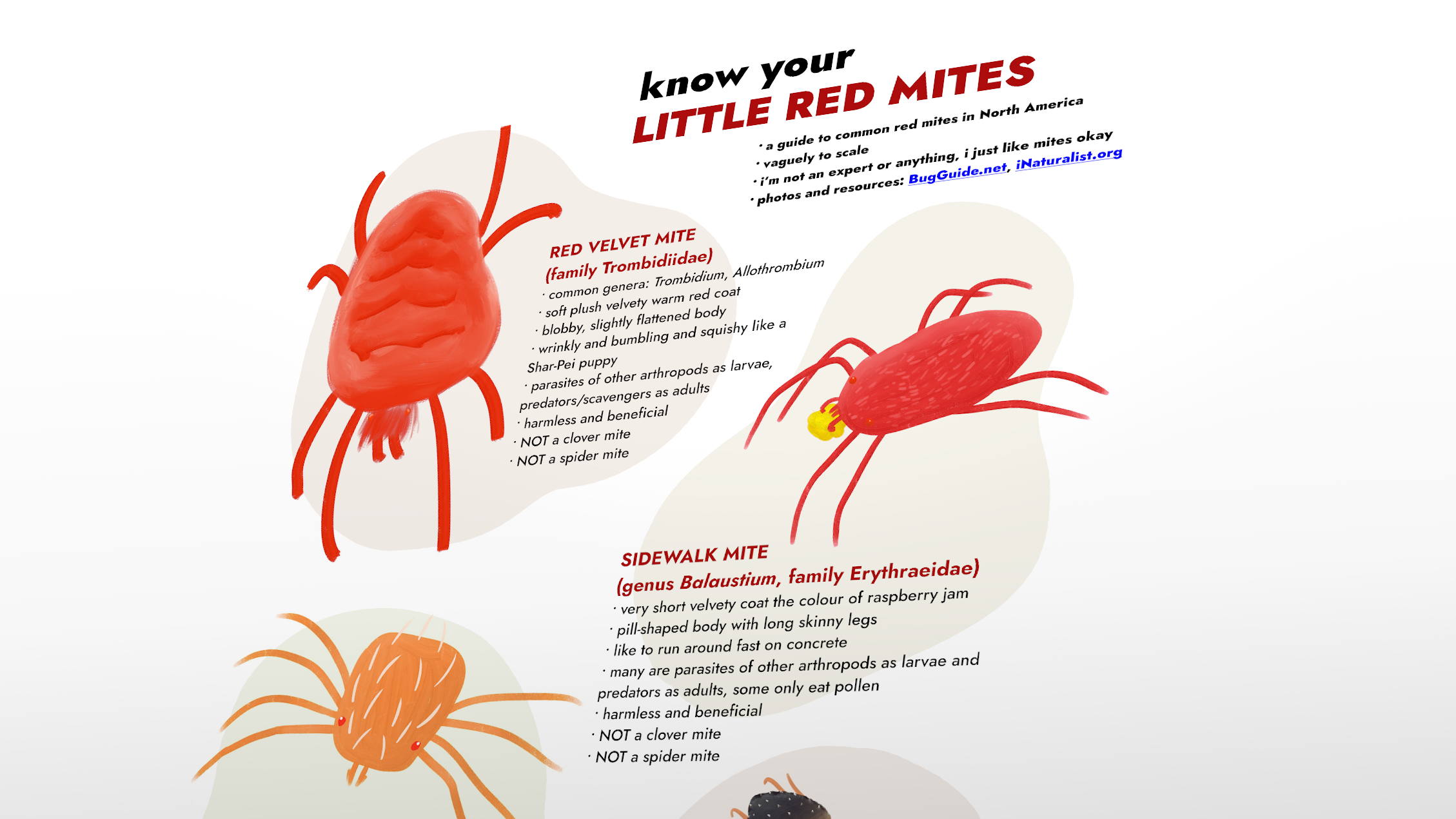
I love your personality descriptions, I was looking for better words other than “fast and busy” on Reddit for an ID trying to stay in the rules, but “ like to run around REALLY FUCKING FAST on leaves, sometimes do lunges to stretch first” sums it up! Thanks
Thanks, I’m glad it was helpful!
this brought me great joy and I’m pretty sure I have some bad bitch fuzzy Y2k fashionista red velvet mites strutting around my house. thx for the most helpful red mite identification guide I’ll have the pleasure of reading
Thank you! This helped me identify the mites probably having a pollen buffet on my balcony. You’ve created a much-needed resource on a neglected subject. I can’t believe wikipedia doesn’t even have a “sidewalk mite” entry :(
You’re very welcome!
I do have a Wikipedia account solely for fixing mite issues. I may see if I can add some resources to the Balaustium page, which is currently just a stub.
Which are the bright red mites that appear in great numbers in the spring and leave a red stain when squished? They are all over my patio and porch steps in the spring. Are those sidewalk mites and not clover mites?
I can’t say for sure without seeing them (or a photo of them), but they are most likely sidewalk mites.
Thank you for doing this. This was the only resource that I was able to find that identified my little sidewalk mite. Glad to know it’s not harmful! 😃👍
Thank you for the wonderful illustration!
These are actually the most helpful descriptions I’ve found trying to tell the difference between these little guys. I love it, thank you!
I have gotten teeny tiny red almost a clear/reddish light brown spider crawling on my arm 3 different times over the past month..kinda quick almost can’t feel them..I happen to see them..not bedbugs I know..but I gotten 4 random bites on my right arm..elbow was swollen and really red..any thoughts on a non bedbug teeny red/lite brown spider that will bite..? And could potentially make bite area red and swollen? (I know not bedbugs)Thx
There are lots of different things—not just bugs—that can cause bite-like sores or symptoms, from mosquitoes to bacterial infections to irritating plants, so I can’t say if the spiders you’ve seen are responsible. Without photos and your geographic location, I am afraid I don’t know what the spiders you’ve been seeing are.